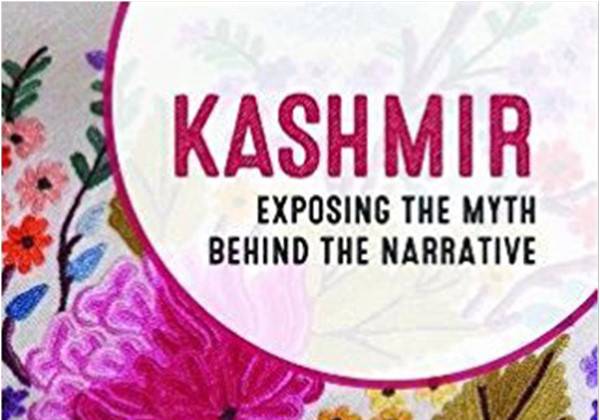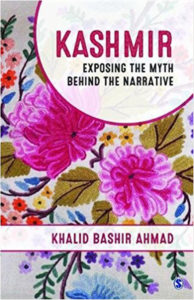
 Kashmir: Exposing the myth behind the narrative by former civil servant Khalid Bashir Ahmad is undoubtedly the first of its kind in recent history because no Muslim scholar has taken on historiography like him. Its 387 pages are dedicated to debunking a narrative that has cast a shadow over Kashmir’s history for a long time. Ironically, though, when it was launched mid-August, readers reacted by zoning in on only one chapter and ignoring the intent of the book, which receded into the background of the debate.
Kashmir: Exposing the myth behind the narrative by former civil servant Khalid Bashir Ahmad is undoubtedly the first of its kind in recent history because no Muslim scholar has taken on historiography like him. Its 387 pages are dedicated to debunking a narrative that has cast a shadow over Kashmir’s history for a long time. Ironically, though, when it was launched mid-August, readers reacted by zoning in on only one chapter and ignoring the intent of the book, which receded into the background of the debate.The uproar came in reaction to Ahmad’s challenge to Kalhana, the author of historical chronicle Rajatarangini written in 1148 AD. This is precisely why Ahmad’s book is significant. Ahmad has the temerity to critically question one of Kalhana’s sources, the Nilamata Purana and accounts by Jonaraja and Srivara in order to expose patterns in historiography or the patterns of writing history. For example, Ahmad points out Kalhana’s method of relying on mythology to chronicle a history of 3,000 years when it could have only been possible for him to record the “real history” of a few hundred years. This chapter is, thus, quite aptly titled “Mind’s Eye” as it goes to Kalhana’s method.
Similarly problematic is Kalhana’s bias against indigenous languages and hence reliance on sources in Sanskrit, with which he was deeply in love. “As with the case of Nilamata Purana and other Sanskrit works which suffered interpolation and distortion,” writes Ahmad, “the Rajatarangini too did not escape textual interference at the hands of those who attempted to either interpret it or use it as the basic source material.” Notwithstanding Ahmad’s argument that only a portion of Rajatarangini could be taken as history, he does credit Kalhana with giving Kashmir an identity by writing its history.
It becomes clear, chapter after chapter, then, that Kashmiri Pandits have woven a certain narrative that has ignored the reality that the valley is Muslim majority. Kashmiri Muslims have been projected as victims despite the fact that power went to their representatives after 1947. Ahmad candidly examines certain “machinations” by the community when certain policies were framed to persecute Muslims even though they were at the helm. This places in context the outlook of Kashmiri Pandits who did not accept the reality and built a perception that Muslims have been persecutors, fundamentalists and usurpers of their ancestry.
This places in context the outlook of Kashmiri Pandits who did not accept the reality and built a perception that Muslims have been persecutors, fundamentalists and usurpers of their ancestry
In the chapter titled “Malice” the author has come out in strong defence of Sultan Sikandar (1389-1413 AD), the sixth ruler of the Shah Mir dynasty, who has been made infamous as “But Shikan” (iconoclast) for his wanton destruction of temples and persecution of subjects. But he proves that conversion of Hindus to Islam had begun three centuries before the establishment of the Muslim sultanate and climaxed by the end of the 15th Century. Ahmad is critical of Baharistan-i-Shahi, an anonymous Persian chronicle whose author cast Sultan Sikandar in a bad light. Kashmiri Pandit writers cite this till today. “The king whom Baharistan-i-Shahi accuses of idol breaking, in fact, installed 18 lined stone inscriptions in Sharda script containing his invocation to Hindu god Ganesha besides constructing dharmanatha and repairing dilapidated temples of antiquity,” Ahmad writes. He goes on to give many examples of how ancient temples have existed in Kashmir and continue to do so. If Sultan Sikandar were responsible for mass conversions, why they did not come to their faith when Budshah Zainul Abidin had asked them to do? The author also questions why the writers have been silent on how Buddhism was wiped out in Kashmir by Mihirkula, a Hun who came to Kashmir in 530 AD.
“Power” is an important chapter that sets the tone of the book as it dwells on how Kashmiri Pandits emerged as key players in power politics, something that has not changed even today. An interesting revelation is that during Mughal rule, Kashmiri Pandits themselves sought to have their title changed to this because they felt inferior when it came to other Brahmans of India. “One such person who endeared himself to one of the last remnants of the Mughal Empire King Muhammad Shah was Jai Ram Bhan who was his courtier,” Ahmad writes. “Bhan persuaded Mohammad Shah to issue [a] royal decree designating Kashmiri Brahmans as Kashmiri Pandits thus drawing a line of distinction between Kashmiri Brahmans and those of India.” After the Kashmiri Pandits left the valley and migrated in 1990, however, they decided that they preferred to be called Kashmiri Hindus (once again) as they wanted to attract the empathy of co-religionists at that given point in time.
So adept were the Pandits that they ruled through the Mughal and Afghan periods to the extent that Pandit Nand Ram Tiku became Prime Minister of Kabul. They were so influential that they succeeded in having Governor Nooruddin Khan removed from Kashmir in 1765 AD. When Atta Mohammad Khan revolted against Afghan rule and ensured Muslim participation in the administration, the Kashmiri Pandits went to Kabul and had the army unseat him. This continued during Sikh rule and Dogra rule and in fact it was Birbal Dhar, the author notes, who invited Ranjit Singh in 1819 AD to conquer Kashmir (though the latter was reluctant).
The book also touches upon events that have only been viewed from one perspective. For example, after Dogra ruler Gulab Singh virtually bought Kashmir along with its people under the Treaty of Amritsar in 1846, the Kashmiri Pandits were on his side. The Pandits also sided with the government when 23 Muslims were killed on July 13, 1931 in police firing in central jail. Ahmad shreds the “new narrative” that emerged after 1990, suggesting that Hindus were killed and temples were destroyed in the aftermath of the jail killing. He quotes Pandit authors to give details of how this particular one-sided story circulated only after the 1990 migration. Authors from the community have not mentioned the so-called looting and mayhem in histories written from 1931 to 1990. Discrimination against Kashmir Muslims was glaring, notes Ahmad as he unravels how the Glancy Commission report was sabotaged by the Pandits. The Commission was set up by Maharaja Hari Singh in November 1931 to address the grievances of Muslims. Ahmad has painstakingly argued with the figures, asking how the administration could be dominated by the Pandits despite the fact that Muslims were in 95 percent majority.
The Pandit agitation of 1964 has received much attention in the book as well. It was when a Kashmiri Pandit girl Parmeshwari married a Kashmiri Muslim Ghulam Rasool and the community exploded. Detailed descriptions are given on how the agitation unfolded under the patronage of the RSS and how it was actually used to denounce the majority community.
Ahmad also writes about the migration of the Kashmiri Pandits. While he makes a strong case that the majority community was not responsible and the government, then led by Governor Jagmohan certainly played a role, he does narrate events that led to the scare. But by quoting many responsible Kashmiri Pandits, he shows how Muslims tried to persuade them against leaving in their own capacity. He also counters the “inflated” figures about the killings and migration with support of official data. The same treatment is given to the damage to temples, which he shows as manipulated based on the facts on the ground.
The book also focuses on how the demand of Panun Kashmir, a separate homeland, is part of the larger agenda of right wing Hindu organisations to re-conquer Kashmir. Also worth reading are the sections on the role played by Kashmiri Pandits who were given prominent media space for a long time and actively participated in dethroning elected governments in Jammu and Kashmir. Ahmad deftly weaves a counter-narrative to mainstream rhetoric that demonized the majority community to seek support of Hindus across India.
One important argument Ahmad raises is that if Kashmiri Pandits claim that Kashmir belongs to them, it also belongs to Muslims who were original inhabitants like them. Conversion does not change the claim of ancestry. But the only logic that can be applied, according to the author, is that since they changed their religion they lost their rights over the land, which is not tenable.
Ahmad relies on research to challenge certain long-assumed ‘truths’, but at the same time, it is worth debating if modern scientific tools of research can “demolish” history that was written about 5,000 years ago. What he accomplishes, though, is alerting us to the need for the debate on this and the question of how and why one community’s bias against the other has not changed despite so much change in geopolitics.
The writer is a senior journalist based in Srinagar (Kashmir) and can be reached at shujaat7867@gmail.com

